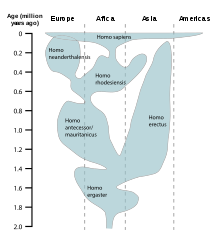Human evolution
Main article: Human evolution
A small African ape living around 6 Ma was the last animal whose descendants would include both modern humans and their closest relatives, the chimpanzees. Only two branches of its family tree have surviving descendants. Very soon after the split, for reasons that are still unclear, apes in one branch developed the ability to walkupright.Brainsize increased rapidly, and by 2 Ma, the first animals classified in the genus Homo had appeared.Of course, the line between different species or even genera is somewhat arbitrary as organisms continuously change over generations. Around the same time, the other branch split into the ancestors of the common chimpanzee and the ancestors of the bonobo as evolution continued simultaneously in all life forms.
The ability to control fire probably began in Homo erectus (or Homo ergaster), probably at least 790,000 years agobut perhaps as early as 1.5 Ma.The use and discovery of controlled fire may even predate Homo erectus. Fire was possibly used by the early Lower Paleolithic (Oldowan) hominid Homo habilis or strong australopithecines such as Paranthropus.
A reconstruction of human history based on fossil data.
It is more difficult to establish the origin of language; it is unclear whether Homo erectus could speak or if that capability had not begun until Homo sapiens.As brain size increased, babies were born earlier, before their heads grew too large to pass through the pelvis. As a result, they exhibited more plasticity, and thus possessed an increased capacity to learn and required a longer period of dependence. Social skills became more complex, language became more sophisticated, and tools became more elaborate. This contributed to further cooperation and intellectual development. Modern humans (Homo sapiens) are believed to have originated around 200,000 years ago or earlier in Africa; the oldest fossils date back to around 160,000 years ago.
The first humans to show signs of spirituality are the Neanderthals (usually classified as a separate species with no surviving descendants); they buried their dead, often with no sign of food or tools.However, evidence of more sophisticated beliefs, such as the early Cro-Magnon cave paintings (probably with magical or religious significance) did not appear until 32,000 years ago.Cro-Magnons also left behind stone figurines such as Venus of Willendorf, probably also signifying religious belief. By 11,000 years ago, Homo sapiens had reached the southern tip of South America, the last of the uninhabited continents (except for Antarctica, which remained undiscovered until 1820 AD). Tool use and communication continued to improve, and interpersonal relationships became more intricate.




Comments
Post a Comment